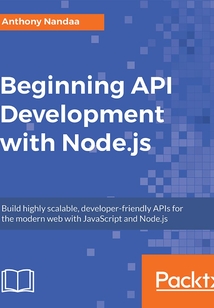舉報 

會員
Beginning API Development with Node.js
Usingthesameframeworktobuildbothserverandclient-sideapplicationssavesyoutimeandmoney.ThisbookteachesyouhowyoucanuseJavaScriptandNode.jstobuildhighlyscalableAPIsthatworkwellwithlightweightcross-platformclientapplications.ItbeginswiththebasicsofNode.jsinthecontextofbackenddevelopment,andquicklyleadsyouthroughthecreationofanexampleclientthatpairsupwithafullyauthenticatedAPIimplementation.Bytheendofthebook,you’llhavetheskillsandexposurerequiredtogethands-onwithyourownAPIdevelopmentproject.
目錄(79章)
倒序
- 封面
- Title Page
- Copyright and Credits
- Beginning API Development with Node.js
- Packt Upsell
- Why Subscribe?
- PacktPub.com
- Contributors
- About the Author
- About the Reviewer
- Packt Is Searching for Authors like You
- Preface
- Who This Book Is For
- What This Book Covers
- To Get the Most out of This Book
- Download the Example Code Files
- Conventions Used
- Get in Touch
- Reviews
- Introduction to Node.js
- The Basics of Node.js
- Applications of Node.js
- Activity: Running Basic Node.js Code
- The Module System
- Application Modularization
- Module Categories
- Built-In Modules
- npm – Third-Party Module Registry
- Scanning for node_modules
- Handy npm Commands
- Local Modules
- Activity: Using a Third-Party Package for the Previous math.js Code
- Asynchronous Programming with Node.js
- Callbacks
- Promises
- Async/Await
- Activity: Transforming a Text File Using an Async Function
- Summary
- Building the API - Part 1
- Building a Basic HTTP Server
- Setting up Hapi.js
- Exercise 1: Building a Basic Hapi.js Server
- Using an API Client
- Returning JSON Strings
- Exercise 2: Returning JSON
- Using nodemon for Development Workflow
- Exercise 3: Using nodemon
- Setting up the Logger
- Exercise 4: Setting up the Logger
- Understanding Requests
- A Look at HTTP Request Methods
- Exercise 5: Getting a List of Resources
- Exercise 6: Getting a Specific Resource
- Exercise 7: Creating a New Todo with POST
- Exercise 8: Updating a Resource with PUT
- Exercise 9: Updating with PATCH
- Exercise 10: Deleting a Resource with DELETE
- Request Validation
- Exercise 11: Validating a Request
- Summary
- Building the API - Part 2
- Working with the DB Using Knex.js
- Exercise 12: Setting up the Database
- Exercise 13: Connecting to the Database
- Exercise 14: Creating a Record
- Exercise 15: Reading from the Database
- Exercise 16: Updating a Record
- Exercise 17: Deleting a Record
- Exercise 18: Cleaning up the Code
- Authenticating Your API with JWT
- Exercise 19: Securing All the Routes
- Exercise 20: Adding User Authentication
- Authentication versus Authorization
- Exercise 21: Implementing Authorization
- Testing Your API with Lab
- Exercise 22: Writing Basic Tests with Lab
- Summary
- Other Books You May Enjoy
- Leave a review - let other readers know what you think 更新時間:2021-07-23 17:22:00
推薦閱讀
- 智能網(wǎng)聯(lián)汽車V2X與智能網(wǎng)聯(lián)設(shè)施I2X
- Hands-On Industrial Internet of Things
- Force.com Development Blueprints
- Learning Karaf Cellar
- HCNA網(wǎng)絡(luò)技術(shù)
- 局域網(wǎng)組建、管理與維護項目教程(Windows Server 2003)
- HTML5 Game development with ImpactJS
- Wireshark網(wǎng)絡(luò)分析就這么簡單
- TCP/IP基礎(chǔ)(第2版)
- 5G非正交多址接入技術(shù):理論、算法與實現(xiàn)
- 物聯(lián)網(wǎng)
- React Design Patterns and Best Practices(Second Edition)
- Corona SDK Application Design
- 趣話通信:6G的前世、今生和未來
- 云計算、網(wǎng)絡(luò)安全和網(wǎng)絡(luò)盜竊:網(wǎng)絡(luò)世界防盜初學指南
- Learning Dart
- Oracle ADF Faces Cookbook
- Full-Stack Web Development with Vue.js and Node
- EtherCAT工業(yè)以太網(wǎng)應(yīng)用技術(shù)
- 華為云物聯(lián)網(wǎng)平臺技術(shù)與實踐
- 計算機網(wǎng)絡(luò)基礎(chǔ)(第4版)
- 互聯(lián)網(wǎng)啟示錄:互聯(lián)網(wǎng)如何改變世界
- Learn Microsoft PowerApps
- BGP設(shè)計與實現(xiàn)
- Vue.js 2 Design Patterns and Best Practices
- SpamAssassin: A practical guide to integration and configuration
- 物聯(lián)網(wǎng)技術(shù):智能家居工程應(yīng)用與實踐
- 路由交換技術(shù)
- The Agile Developer's Handbook
- MPLS技術(shù)構(gòu)架

